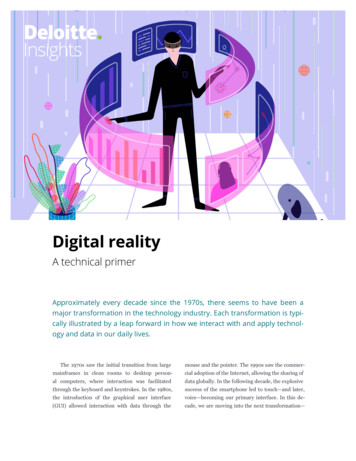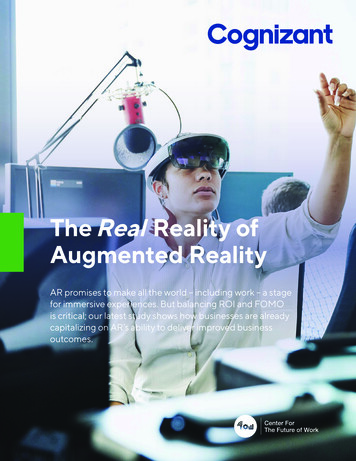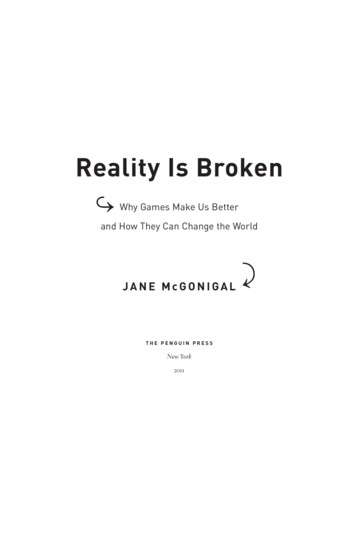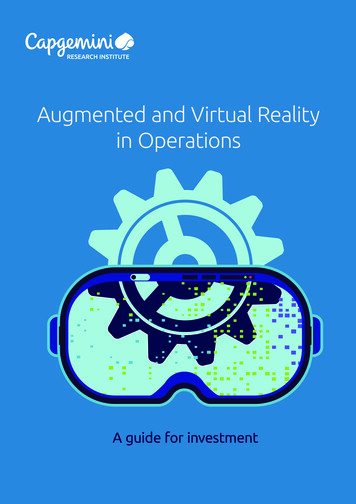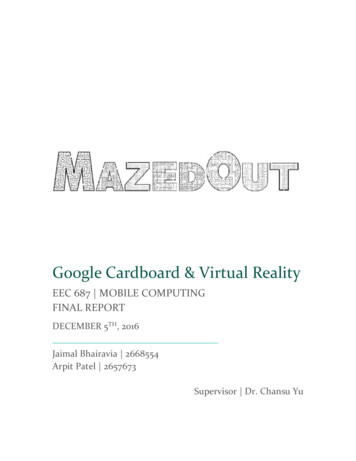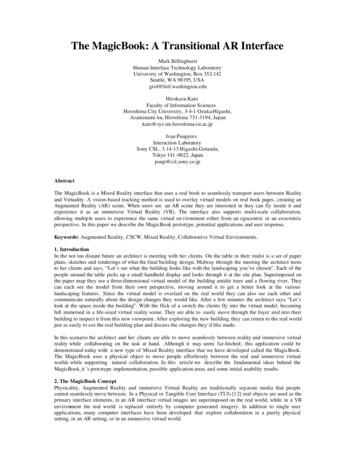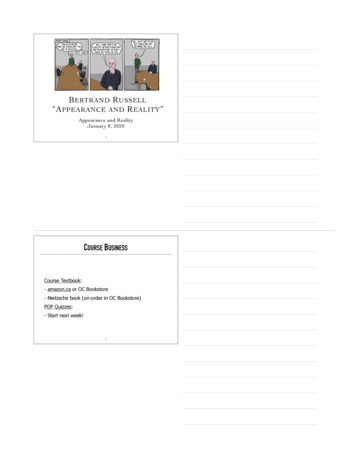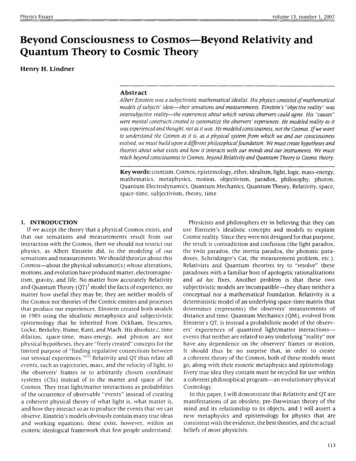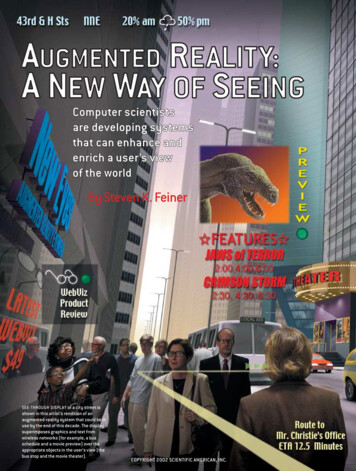
Transcription
AUGMENTED REALITY:A NEW WAY OF SEEINGComputer scientistsare developing systemsthat can enhance andenrich a user’s viewof the worldBy Steven K. FeinerSEE-THROUGH DISPLAY of a city street isshown in this artist’s rendition of anaugmented-reality system that could be inuse by the end of this decade. The displaysuperimposes graphics and text fromwireless networks (for example, a busschedule and a movie preview) over theappropriate objects in the user’s view (thebus stop and the movie theater).COPYRIGHT 2002 SCIENTIFIC AMERICAN, INC.
COPYRIGHT 2002 SCIENTIFIC AMERICAN, INC.
What willIf we extrapolate from current systems, it’s easy to imagine aproliferation of high-resolution displays, ranging from tinyhandheld or wrist-worn devices to large screens built into desks,walls and floors. Such displays will doubtless become commonplace. But I and many other computer scientists believe thata fundamentally different kind of user interface known as augmented reality will have a more profound effect on the way inwhich we develop and interact with future computers.Augmented reality (AR) refers to computer displays that addvirtual information to a user’s sensory perceptions. Most AR research focuses on “see-through” devices, usually worn on thehead, that overlay graphics and text on the user’s view of his orher surroundings. (Virtual information can also be in other sensory forms, such as sound or touch, but this article will concentrate on visual enhancements.) AR systems track the position andorientation of the user’s head so that the overlaid material can bealigned with the user’s view of the world. Through this process,known as registration, graphics software can place a three-dimensional image of a teacup, for example, on top of a real saucerand keep the virtual cup fixed in that position as the user movesabout the room. AR systems employ some of the same hardwaretechnologies used in virtual-reality research, but there’s a crucialdifference: whereas virtual reality brashly aims to replace the realworld, augmented reality respectfully supplements it.Consider what AR could make routinely possible. A repairperson viewing a broken piece of equipment could see instructions highlighting the parts that need to be inspected. Asurgeon could get the equivalent of x-ray vision by observinglive ultrasound scans of internal organs that are overlaid on thepatient’s body. Firefighters could see the layout of a burningOverview/Augmented RealityAugmented-reality (AR) systems add computergenerated information to a user’s sensory perceptions.Whereas virtual reality aims to replace the real world,augmented reality supplements it. Most research focuses on “see-through” devices, usuallyworn on the head, that overlay graphics and text on theuser’s view of the world. Recent technological improvements may soon lead tothe introduction of AR systems for surgeons,repairpeople, soldiers, tourists and computer gamers.Eventually the systems may become commonplace. 50building, allowing them to avoid hazards that would otherwisebe invisible. Soldiers could see the positions of enemy sniperswho had been spotted by unmanned reconnaissance planes. Atourist could glance down a street and see a review of eachrestaurant on the block. A computer gamer could battle 10foot-tall aliens while walking to work.Getting the right information at the right time and the rightplace is key in all these applications. Personal digital assistantssuch as the Palm and the Pocket PC can provide timely information using wireless networking and Global Positioning System (GPS) receivers that constantly track the handheld devices.But what makes augmented reality different is how the information is presented: not on a separate display but integratedwith the user’s perceptions. This kind of interface minimizes theextra mental effort that a user has to expend when switching hisor her attention back and forth between real-world tasks and acomputer screen. In augmented reality, the user’s view of theworld and the computer interface literally become one.Although augmented reality may seem like the stuff of sciencefiction, researchers have been building prototype systems formore than three decades. The first was developed in the 1960sby computer graphics pioneer Ivan Sutherland and his studentsat Harvard University and the University of Utah. In the 1970sand 1980s a small number of researchers studied augmented reality at institutions such as the U.S. Air Force’s Armstrong Laboratory, the NASA Ames Research Center and the University ofNorth Carolina at Chapel Hill. It wasn’t until the early 1990sthat the term “augmented reality” was coined by scientists atBoeing who were developing an experimental AR system to helpworkers assemble wiring harnesses. The past decade has seen aflowering of AR research as hardware costs have fallen enoughto make the necessary lab equipment affordable. Scientists havegathered at yearly AR conferences since 1998.Despite the tremendous changes in information technologysince Sutherland’s groundbreaking work, the key componentsneeded to build an AR system have remained the same: displays, trackers, and graphics computers and software. The performance of all these components has improved significantly inrecent years, making it possible to design experimental systemsthat may soon be developed into commercial products.Seeing Is BelievingBY DEFINITION,the see-through displays in AR systems mustbe able to present a combination of virtual and real information. Although the displays can be handheld or stationary, theySCIENTIFIC AMERICANAPRIL 2002COPYRIGHT 2002 SCIENTIFIC AMERICAN, INC.PAT RAWLINGS/SAIC (preceding pages)COMPUTER USER INTERFACES look like10 years from now?
OPTICAL SEE-THROUGH DISPLAYOPTICAL SYSTEMS superimposecomputer graphics on the user’s viewof the world. In this current design, theprisms reflect the graphics on a liquidcrystal display into the user’s line ofsight yet still allow light from thesurrounding world to pass through. Asystem of sensors and targets keepstrack of the position and orientation ofthe user’s head, ensuring that thegraphics appear in the correct places.But in present-day optical systems,the graphics cannot completelyobscure the objects behind them.LIQUID-CRYSTAL DISPLAY231FREE-FORMSURFACE PRISMCOMPENSATING PRISM1ILLUSTRATION BY BRYAN CHRISTIE DESIGN, BASED ON A PROTOTYPEDISPLAY BY MIXED REALITY SYSTEMS LABORATORY, INC.View of thereal world froma computer gamer’sperspective2Graphicssynthesizedby the augmentedreality system3Image onoptical displaywith superimposedgraphicsare most often worn on the head. Positioned just in front of theeye, a physically small screen can create a virtually large image.Head-worn displays are typically referred to as head-mounteddisplays, or HMDs for short. (I’ve always found it odd, however, that anyone would want to “mount” something on his orher head, so I prefer to call them head-worn displays.)The devices fall into two categories: optical see-through andvideo see-through. A simple approach to optical see-through display employs a mirror beam splitter— a half-silvered mirror thatboth reflects and transmits light. If properly oriented in front ofthe user’s eye, the beam splitter can reflect the image of a computer display into the user’s line of sight yet still allow light fromthe surrounding world to pass through. Such beam splitters,which are called combiners, have long been used in “head-up”displays for fighter-jet pilots (and, more recently, for drivers ofluxury cars). Lenses can be placed between the beam splitter andthe computer display to focus the image so that it appears at acomfortable viewing distance. If a display and optics are provided for each eye, the view can be in stereo [see illustration above].In contrast, a video see-through display uses video mixingtechnology, originally developed for television special effects,to combine the image from a head-worn camera with synthesized graphics [see illustration on next page]. The merged image is typically presented on an opaque head-worn display.With careful design, the camera can be positioned so that itsoptical path is close to that of the user’s eye; the video imageDISPLAY UTERthus approximates what the user would normally see. As withoptical see-through displays, a separate system can be provided for each eye to support stereo vision.In one method for combining images for video see-throughdisplays, the synthesized graphics are set against a reserved background color. One by one, pixels from the video camera imageare matched with the corresponding pixels from the synthesizedgraphics image. A pixel from the camera image appears in thedisplay when the pixel from the graphics image contains thebackground color; otherwise the pixel from the graphics imageis displayed. Consequently, the synthesized graphics obscure thereal objects behind them. Alternatively, a separate channel of information stored with each pixel can indicate the fraction of thatpixel that should be determined by the virtual information. Thistechnique allows the display of semitransparent graphics. Andif the system can determine the distances of real objects from theviewer, computer graphics algorithms can also create the illusionthat the real objects are obscuring virtual objects that are fartheraway. (Optical see-through displays have this capability as well.)Each of the approaches to see-through display design hasits pluses and minuses. Optical see-through systems allow theuser to see the real world with full resolution and field of view.But the overlaid graphics in current optical see-through systemsare not opaque and therefore cannot completely obscure thephysical objects behind them. As a result, the superimposed textmay be hard to read against some backgrounds, and the three-www.sciam.comSCIENTIFIC AMERICANCOPYRIGHT 2002 SCIENTIFIC AMERICAN, INC.51
dimensional graphics may not produce a convincing illusion.Furthermore, although a user focuses physical objects depending on their distance, virtual objects are all focused in the planeof the display. This means that a virtual object that is intendedto be at the same position as a physical object may have a geometrically correct projection, yet the user may not be able toview both objects in focus at the same time.In video see-through systems, virtual objects can fully obscure physical ones and can be combined with them using a richvariety of graphical effects. There is also no discrepancy between how the eye focuses virtual and physical objects, becauseboth are viewed on the same plane. The limitations of currentvideo technology, however, mean that the quality of the visualexperience of the real world is significantly decreased, essentially to the level of the synthesized graphics, with everythingfocusing at the same apparent distance. At present, a video camera and display are no match for the human eye.The earliest see-through displays devised by Sutherland andhis students were cumbersome devices containing cathode-raytubes and bulky optics. Nowadays researchers use small liquidcrystal displays and advanced optical designs to create systemsthat weigh mere ounces. More improvements are forthcoming:a company called Microvision, for instance, has recently developed a device that uses low-power lasers to scan images directly on the retina [see “Eye Spy,” by Phil Scott; News Scan,Scientific American, September 2001]. Some prototypehead-worn displays look much like eyeglasses, making themrelatively inconspicuous. Another approach involves projecting graphics directly on surfaces in the user’s environment.Keeping Trackof augmented-reality systems isto correctly match the overlaid graphics with the user’s view ofthe surrounding world. To make that spatial relation possible,the AR system must accurately track the position and orientation of the user’s head and employ that information when rendering the graphics. Some AR systems may also require certainmoving objects to be tracked; for example, a system that provides visual guidance for a mechanic repairing a jet engine mayneed to track the positions and orientations of the engine’s partsduring disassembly. Because the tracking devices typically monitor six parameters for each object— three spatial coordinates(x, y and z) and three orientation angles (pitch, yaw and roll) —they are often called six-degree-of-freedom trackers.In their prototype AR systems, Sutherland and his colleagues experimented with a mechanical head tracker suspended from the ceiling. They also tried ultrasonic trackersthat transmitted acoustic signals to determine the user’s position. Since then, researchers have developed improved versionsof these technologies, as well as electromagnetic, optical andA CRUCIAL REQUIREMENTVIDEO SEE-THROUGH DISPLAYLIQUID-CRYSTALDISPLAYVIDEO SYSTEMS mix computer3FREE-FORMSURFACE PRISMWEDGEPRISMIMAGING LENS1CHARGE-COUPLEDDEVICEDISPLAY ANDTRACKINGSENSORS1View of the realworld capturedand convertedto a video image522Computergraphics setagainst a reservedbackground color3Merged imageshown onthe IFIC AMERICANVIRTUALSPIDERAPRIL 2002COPYRIGHT 2002 SCIENTIFIC AMERICAN, INC.ILLUSTRATION BY BRYAN CHRISTIE DESIGN, BASED ON A PROTOTYPEDISPLAY BY MIXED REALITY SYSTEMS LABORATORY, INC.graphics with camera images thatapproximate what the user wouldnormally see. In this design, lightfrom the surrounding world iscaptured by a wedge prism andfocused on a charge-coupled devicethat converts the light to digital videosignals. The system combines thevideo with computer graphics andpresents the merged images on the2liquid-crystal display. Video systemscan produce opaque graphics butcannot yet match the resolution andCOMPUTERrange of the human eye.(WORN ON HIP)
The user’s VIEW OF THE WORLDand the computer interfaceLITERALLY BECOME ONE.Unfortunately, GPS is not the ultimate answer to positiontracking. The satellite signals are relatively weak and easilyblocked by buildings or even foliage. This rules out useful tracking indoors or in places like midtown Manhattan, where rows oftall buildings block most of the sky. We found that GPS trackingworks well in the central part of Columbia’s campus, which haswide open spaces and relatively low buildings. GPS, however,provides far too few updates per second and is too inaccurate tosupport the precise overlaying of graphics on nearby objects.Augmented-reality systems place extraordinarily high demands on the accuracy, resolution, repeatability and speed oftracking technologies. Hardware and software delays introducea lag between the user’s movement and the update of the display. As a result, virtual objects will not remain in their properpositions as the user moves about or turns his or her head. Onetechnique for combating such errors is to equip AR systems withsoftware that makes short-term predictions about the user’s future motions by extrapolating from previous movements. Andin the long run, hybrid trackers that include computer visiontechnologies may be able to trigger appropriate graphics overlays when the devices recognize certain objects in the user’s view.Managing RealityT H E P E R F O R M A N C E O F G R A P H I C S hardware and softwarehas improved spectacularly in the past few years. In the 1990sour lab had to build its own computers for our outdoor AR systems because no commercially available laptop could producethe fast 3-D graphics that we wanted. In 2001, however, we werefinally able to switch to a commercial laptop that had sufficientlypowerful graphics chips. In our experimental mobile systems,the laptop is mounted on a backpack. The machine has the advantage of a large built-in display, which we leave open to allowbystanders to see what the overlaid graphics look like alone.THE AUTHORvideo trackers. Trackers typically have two parts: one worn bythe tracked person or object and the other built into the surrounding environment, usually within the same room. In optical trackers, the targets— LEDs or reflectors, for instance—can be attached to the tracked person or object, and an arrayof optical sensors can be embedded in the room’s ceiling. Alternatively, the tracked users can wear the sensors, and the targets can be fixed to the ceiling. By calculating the distance toeach visible target, the sensors can determine the user’s position and orientation.In everyday life, people rely on several senses— includingwhat they see, cues from their inner ears and gravity’s pull ontheir bodies— to maintain their bearings. In a similar fashion,“hybrid trackers” draw on several sources of sensory information. For example, the wearer of an AR display can be equippedwith inertial sensors (gyroscopes and accelerometers) to recordchanges in head orientation. Combining this information withdata from the optical, video or ultrasonic devices greatly improves the accuracy of the tracking.But what about AR systems designed for outdoor use? Howcan you track a person when he or she steps outside the roompacked with sensors? The outdoor AR system designed by ourlab at Columbia University handles orientation and positiontracking separately. Head orientation is determined with acommercially available hybrid tracker that combines gyroscopes and accelerometers with a magnetometer that measuresthe earth’s magnetic field. For position tracking, we take advantage of a high-precision version of the increasingly popularGlobal Positioning System receiver.A GPS receiver determines its position by monitoring radiosignals from navigation satellites. The accuracy of the inexpensive, handheld receivers that are currently available is quitecoarse— the positions can be off by many meters. Users can getbetter results with a technique known as differential GPS. In thismethod, the mobile GPS receiver also monitors signals from another GPS receiver and a radio transmitter at a fixed location onthe earth. This transmitter broadcasts corrections based on thedifference between the stationary GPS antenna’s known andcomputed positions. By using these signals to correct the satellite signals, differential GPS can reduce the margin of error toless than one meter. Our system is able to achieve centimeterlevel accuracy by employing real-time kinematic GPS, a moresophisticated form of differential GPS that also compares thephases of the signals at the fixed and mobile receivers.STEVEN K. FEINER is professor of computer science at ColumbiaUniversity, where he directs the Computer Graphics and User Interfaces Lab. He received a Ph.D. in computer science from BrownUniversity in 1987. In addition to performing research on softwareand user interfaces for augmented reality, Feiner and his colleagues are developing systems that automate the design andlayout of interactive graphics and multimedia presentations indomains ranging from medicine to government databases. The research described in this article was supported in part by the Office of Naval Research and the National Science Foundation.www.sciam.comSCIENTIFIC AMERICANCOPYRIGHT 2002 SCIENTIFIC AMERICAN, INC.53
Part of what makes reality real is its constant state of flux.AR software must constantly update the overlaid graphics asthe user and visible objects move about. I use the term “environment management” to describe the process of coordinatingthe presentation of a large number of virtual objects on manydisplays for many users. Working with Simon J. Julier, LarryJ. Rosenblum and others at the Naval Research Laboratory, weare developing a software architecture that addresses this problem. Suppose that we wanted to introduce our lab to a visitorby annotating what he or she sees. This would entail selectingthe parts of the lab to annotate, determining the form of the annotations (for instance, labels) and calculating each label’s position and size. Our lab has developed prototype software thatinteractively redesigns the geometry of virtual objects to maintain the desired relations among them and the real objects inthe user’s view. For example, the software can continually recompute a label’s size and position to ensure that it is alwaysvisible and that it overlaps only the appropriate object.It is important to note that a number of useful applicationsof AR require relatively little graphics power: we already seethe real world without having to render it. (In contrast, virtual-reality systems must always create a 3-D setting for the user.)In a system designed for equipment repair, just one simple arrow or highlight box may be enough to show the next step ina complicated maintenance procedure. In any case, for mobileAR to become practical, computers and their power suppliesmust become small enough to be worn comfortably. I used tosuggest that they needed to be the size of a Walkman, but a better target might be the even smaller MP3 player.The Touring Machine and MARSW H E R E A S M A N Y A R D E S I G N S have focused on developingbetter trackers and displays, our laboratory has concentratedon the design of the user interface and the software infrastructure. After experimenting with indoor AR systems in the early1990s, we decided to build our first outdoor system in 1996to find out how it might help a tourist exploring an unfamiliarenvironment. We called our initial prototype the Touring Machine (with apologies to Alan M. Turing, whose abstract Turing machine defines what computers are capable of computing).Because we wanted to minimize the constraints imposed by current technology, we combined the best components we couldfind to create a test bed whose capabilities are as close as we canmake them to the more powerful machines we expect in the future. We avoided (as much as possible) practical concerns suchas cost, size, weight and power consumption, confident thatthose problems will be overcome by hardware designers in thecoming years. Trading off physical comfort for performanceand ease of software development, we have built several generations of prototypes using external-frame backpacks. In general, we refer to these as mobile AR systems (or MARS, forshort) [see left illustration below].Our current system uses a Velcro-covered board and strapsto hold many of the components: the laptop computer (with itsCOLUMBIA UNIVERSITY’S Computer Graphics and User Interfaces Lab built an experimentaloutdoor system designed to help a tourist explore the university’s campus. The laptopon the user’s backpack supplies the computer graphics that are superimposed onthe optical see-through display. GPS receivers track the user’s position.The lab created a historicaldocumentary that showsthree-dimensional imagesof the BloomingdaleAsylum, the prior occupantof Columbia’s campus,at its original location.A user viewing thedocumentary can getadditional informationfrom a handheld display,which provides aninteractive timeline ofthe Bloomingdale Asylum’shistory.54SCIENTIFIC AMERICANMEDICAL APPLICATION was built byresearchers at the University ofCentral Florida. The system overlaida model of a knee joint on the view ofa woman’s leg. The researcherstracked the leg’s position usinginfrared LEDs. As the woman benther knee, the graphics showed howthe bones would move.APRIL 2002COPYRIGHT 2002 SCIENTIFIC AMERICAN, INC.TOBIAS HOLLERER, STEVEN K. FEINER AND JOHN PAVLIK Computer Graphics and User Interfaces Lab,Columbia University (mobile AR documentaries); JANNICK ROLLAND Optical Diagnostics and ApplicationsLaboratory, School of Optics, University of Central Florida (knee joint)GLIMPSES OF AUGMENTED REALITY
The OVERLAID INFORMATIONwill become part of what we expectto see AT WORK AND AT PLAY.3-D graphics chip set and IEEE 802.11b wireless networkcard), trackers (a real-time kinematic GPS receiver, a GPS corrections receiver and the interface box for the hybrid orientation tracker), power (batteries and a regulated power supply),and interface boxes for the head-worn display and interactiondevices. The total weight is about 11 kilograms (25 pounds).Antennas for the GPS receiver and the GPS corrections receiver are mounted at the top of the backpack frame, and the userwears the head-worn see-through display and its attached orientation tracker sensor. Our MARS prototypes allow users tointeract with the display— to scroll, say, through a menu ofchoices superimposed on the user’s view— by manipulating awireless trackball or touch pad.From the very beginning, our system has also included ahandheld display (with stylus input) to complement the headworn see-through display. This hybrid user interface offers thebenefits of both kinds of interaction: the user can see 3-D graphics on the see-through display and, at the same time, access additional information on the handheld display.In collaboration with my colleague John Pavlik and his students in Columbia’s Graduate School of Journalism, we haveexplored how our MARS prototypes can embed “situated documentaries” in the surrounding environment. These documentaries narrate historical events that took place in the user’s immediate area by overlaying 3-D graphics and sound on whatthe user sees and hears. Standing at Columbia’s sundial andlooking through the head-worn display, the user sees virtualflags planted around the campus, each of which represents several sections of the story linked to that flag’s location. When theuser selects a flag and then chooses one of the sections, it is presented on both the head-worn and the handheld displays.One of our situated documentaries tells the story of the student demonstrations at Columbia in 1968. If the user choosesone of the virtual flags, the head-worn display presents a narrated set of still images, while the handheld display shows videosnippets and provides in-depth information about specific participants and incidents. In our documentary on the prior occupant of Columbia’s current campus, the Bloomingdale Asylum,3-D models of the asylum’s buildings (long since demolished)are overlaid at their original locations on the see-through display. Meanwhile the handheld display presents an interactiveannotated timeline of the asylum’s history. As the user choosesdifferent dates on the timeline, the images of the buildings thatexisted at those dates fade in and out on the see-through display.The Killer App?A S R E S E A R C H E R S C O N T I N U E to improve the tracking, display and mobile processing components of AR systems, theseamless integration of virtual and sensory information may become not merely possible but commonplace. Some observershave suggested that one of the many potential applications ofaugmented reality (computer gaming, equipment maintenance,medical imagery and so on) will emerge as the “killer app”— ause so compelling that it would result in mass adoption of thetechnology. Although specific applications may well be a driving force when commercial AR systems initially become available, I believe that the systems will ultimately become much liketelephones and PCs. These familiar devices have no single driving application but rather a host of everyday uses.The notion of computers being inextricably and transparently incorporated into our daily lives is what computer scientist Mark Weiser termed “ubiquitous computing” more than adecade ago [see “The Computer for the 21st Century,” by MarkWeiser; Scientific American, September 1991]. In a similarway, I believe the overlaid information of AR systems will become part of what we expect to see at work and at play: labelsand directions when we don’t want to get lost, reminders whenwe don’t want to forget and, perhaps, a favorite cartoon character popping out from the bushes to tell a joke when we wantto be amused. When computer user interfaces are potentiallyeverywhere we look, this pervasive mixture of reality and virtuality may become the primary medium for a new generationof artists, designers and storytellers who will craft the future.MORE TO E XPLOREA Survey of Augmented Reality. Ronald T. Azuma in Presence:Teleoperators and Virtual Environments, Vol. 6, No. 4, pages 355–385;August 1997. Available at www.cs.unc.edu/ azuma/ARpresence.pdfRecent Advances in Augmented Reality. Ronald T. Azuma, Yohan Baillot,Reinhold Behringer, Steven K. Feiner, Simon Julier and Blair MacIntyre inIEEE Computer Graphics and Applications, Vol. 21, No. 6, pages 34–47;November/December 2001. Available atwww.cs.unc.edu/ azuma/cga2001.pdfColumbia University’s Computer Graphics and User Interfaces Lab is atwww.cs.columbia.edu/graphics/A list of relevant publications can be found ations.htmlAR research sites and conferences are listed atwww.augmented-reality.orgInformation on medical applications of augmented reality is atwww.cs.unc.edu/ us/www.sciam.comSCIENTIFIC AMERICANCOPYRIGHT 2002 SCIENTIFIC AMERICAN, INC.55
technologies used in virtual-reality research, but there's a crucial difference: whereas virtual reality brashly aims to replace the real world, augmented reality respectfully supplements it. Consider what AR could make routinely possible. A re-pairperson viewing a broken piece of equipment could see in-
